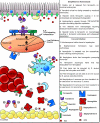A battle for iron: host sequestration and Staphylococcus aureus acquisition
- PMID: 22123296
- PMCID: PMC3785375
- DOI: 10.1016/j.micinf.2011.11.001
A battle for iron: host sequestration and Staphylococcus aureus acquisition
Abstract
The use of iron as an enzymatic cofactor is pervasive in biological systems. Consequently most living organisms, including pathogenic bacteria, require iron to survive and replicate. To combat infection vertebrates have evolved sophisticated iron sequestration systems against which, pathogenic bacteria have concomitantly evolved equally elaborate iron acquisition mechanisms.
Copyright © 2011 Institut Pasteur. Published by Elsevier Masson SAS. All rights reserved.
Figures
Similar articles
-
Molecular mechanisms of Staphylococcus aureus iron acquisition.Annu Rev Microbiol. 2011;65:129-47. doi: 10.1146/annurev-micro-090110-102851. Annu Rev Microbiol. 2011. PMID: 21639791 Free PMC article. Review.
-
Microbiology. Pathogenic bacteria prefer heme.Science. 2004 Sep 10;305(5690):1577-8. doi: 10.1126/science.1102975. Science. 2004. PMID: 15361615 No abstract available.
-
Staphylococcus aureus IsdB is a hemoglobin receptor required for heme iron utilization.J Bacteriol. 2006 Dec;188(24):8421-9. doi: 10.1128/JB.01335-06. Epub 2006 Oct 13. J Bacteriol. 2006. PMID: 17041042 Free PMC article.
-
Heme protects Pseudomonas aeruginosa and Staphylococcus aureus from calprotectin-induced iron starvation.J Biol Chem. 2021 Jan-Jun;296:100160. doi: 10.1074/jbc.RA120.015975. Epub 2020 Dec 9. J Biol Chem. 2021. PMID: 33273016 Free PMC article.
-
Metal ion acquisition in Staphylococcus aureus: overcoming nutritional immunity.Semin Immunopathol. 2012 Mar;34(2):215-35. doi: 10.1007/s00281-011-0294-4. Epub 2011 Nov 3. Semin Immunopathol. 2012. PMID: 22048835 Free PMC article. Review.
Cited by
-
Staphylococcus aureus lipoproteins in infectious diseases.Front Microbiol. 2022 Oct 3;13:1006765. doi: 10.3389/fmicb.2022.1006765. eCollection 2022. Front Microbiol. 2022. PMID: 36262324 Free PMC article. Review.
-
Comprehensive Virulence Gene Profiling of Bovine Non-aureus Staphylococci Based on Whole-Genome Sequencing Data.mSystems. 2019 Mar 5;4(2):e00098-18. doi: 10.1128/mSystems.00098-18. eCollection 2019 Mar-Apr. mSystems. 2019. PMID: 30863792 Free PMC article.
-
Iron at the Centre of Candida albicans Interactions.Front Cell Infect Microbiol. 2018 Jun 5;8:185. doi: 10.3389/fcimb.2018.00185. eCollection 2018. Front Cell Infect Microbiol. 2018. PMID: 29922600 Free PMC article. Review.
-
Vaccine protection of leukopenic mice against Staphylococcus aureus bloodstream infection.Infect Immun. 2014 Nov;82(11):4889-98. doi: 10.1128/IAI.02328-14. Epub 2014 Sep 2. Infect Immun. 2014. PMID: 25183728 Free PMC article.
-
Characterization of Staphylococcus aureus responses to spermine stress.Curr Microbiol. 2014 Sep;69(3):394-403. doi: 10.1007/s00284-014-0603-y. Epub 2014 May 11. Curr Microbiol. 2014. PMID: 24816537
References
-
- Kuehnert MJ, et al. Prevalence of Staphylococcus aureus nasal colonization in the United States, 2001–2002. J Infect Dis. 2006;193(2):172–9. - PubMed
-
- Todd B. Beyond MRSA: VISA and VRSA: what will ward off these pathogens in health care facilities? Am J Nurs. 2006;106(4):28–30. - PubMed
-
- CDC HIV/AIDS Surveillance Report. 2007;17
-
- Bullen JJ, et al. Iron and infection: the heart of the matter. FEMS Immunol Med Microbiol. 2005;43(3):325–30. - PubMed
Publication types
MeSH terms
Substances
Grants and funding
LinkOut - more resources
Full Text Sources
Other Literature Sources
Medical


